
 |
Return to Our Spring Trip to Florida |
Today, we have planned a visit to the Fairchild Tropical Botanic Garden, which is somewhat south of downtown Miami. Fred and I have been to Parrot Jungle, which is in the same general area, but did not know about Fairchild until Steve suggested it. Since we are already down here in Miami, we thought it would be a good stop to make.
The History of Fairchild Tropical Botanic Garden
Dr. Fairchild retired to Miami in 1935, sharing his vast knowledge and experience in tropical plants with Col. Robert H. Montgomery, who founded the botanical garden and named it to honor his friend. Many plants still growing in the Garden were collected and planted by Dr. Fairchild, including a giant African baobab tree not far from the entrance. Before WWII, Dr. Fairchild conducted collecting expeditions to the Far East for FTBG.
Opened to the public in 1938, Fairchild was established on an 83-acre site south of Miami purchased by Col. Montgomery and later deeded in large part to Miami-Dade County. Fairchild Tropical Botanic Garden was designed by renowned landscape architect William Lyman Phillips, member of the Frederick Law Olmsted partnership, and the leading landscape designer in South Florida during the 1930s.
The first 15 years saw the construction of its primary buildings and landscape features, including the Montgomery Palmetum, Bailey Palm Glade, Allee and Overlook, Vine Pergola, Amphitheatre, Gate House, Montgomery Library and Museum, 11 lakes, stone terracing walls, irrigation systems, Moos Sunken Garden, and Nell Montgomery Garden House auditorium. Later buildings included the Davis House (1953), Hawkes Laboratory (1960), Robbins Plant Science Building (1967), Rare Plant House (1968), Corbin Education Building (1972), and various additions over the years. A comprehensive master plan developed in 1993 provides a framework for continued growth and development.
Assembling and maintaining an outstanding botanical collection has been a fundamental part of the institution's existence since 1938; the palms and cycads are still the most significant Fairchild collections. Since Hurricane Andrew in 1992, Fairchild plant collecting efforts have intensified dramatically, as scientists seek not only to restore the FTBG collections, but also to identify and save endangered plants throughout the tropics. Since 1938, FTBG has distributed plants and seeds both to fellow scientists and to members of the local community. Fairchild palms, cycads, ornamentals and fruit trees have been a source of new varieties for commercial growers and home gardeners alike.
Getting to the Fairchild Tropical Botanic Garden
|
We simply take Le Jeune Road south until it comes to a traffic circle at Old Cutler Road. Old Cutler road winds generally southwest, following the shoreline of Biscayne Bay, which is about a mile to the east.
After about three or four miles, we saw the sign for Fairchild Gardens, turned in, parked, and headed to the entrance. As we have learned to do, we asked if there was any reciprocal arrangement for members of the Dallas Arboretum, and we found that Arboretum members get in to Fairchild for free (saving us $25 each). Guy's entrance, of course, we paid for.
An Orientation to Fairchild Tropical Botanic Garden
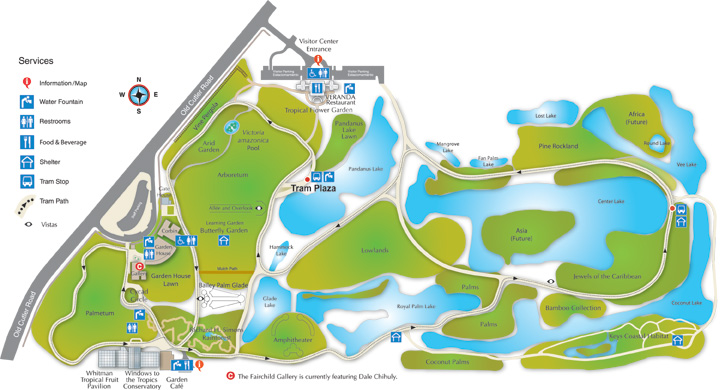 |
At the east end of the garden, towards Biscayne Bay, there are large areas devoted to particular ecosystems amid many small lakes and ponds. Here you can find a pine barren ecosystem, a lowlands ecosystem, palms and coconut palms and bamboo stands. There is also an area devoted to plants of the Caribbean. Two areas are under development, one which will be devoted to plants of Africa and the other to plants of Asia.
In our walks today, we'll be making a loop, generally, from the the Visitor Center to the cafe on the south side of the garden, through the greenhouses in the southwest corner, and then back north along the west side of the gardens. Then, we'll return to the center of the garden and then ride the little tram (which we haven't done before) as it makes a big loop to the east and back, going towards Biscayne Bay through the garden's east side.
Walking from the Visitor Center to the Cafe
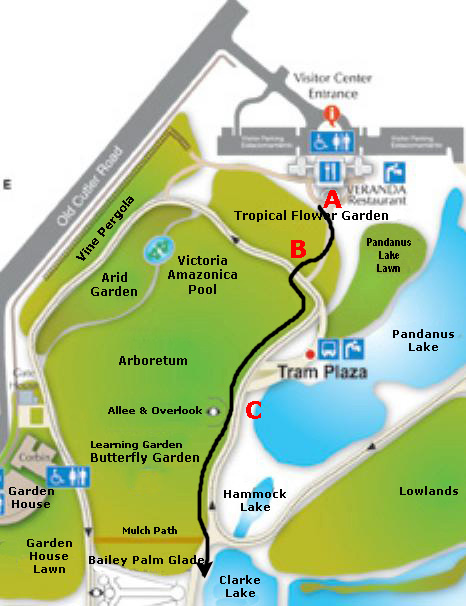 |
 |
So we have come out to the south side of the visitor center through the tunnel under verandah and double staircase that leads to the restaurant upstairs. Below is a nice picture that Fred took of Guy and I standing at point "A" on the garden diagram at left.
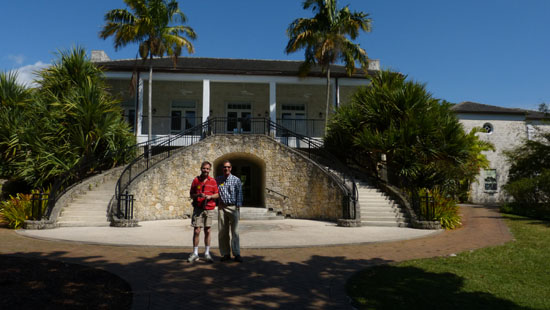 |
Immediately south of the visitor center, we walked through the Tropical Flower Garden and down the path to the beginning of the walkway that would lead south towards Clarke Lake.
|
At the Beginning of Our Walk Through Fairchild Gardens |

|
Before we start down the path to the back of the garden, I want to show you a picture of one of the most unusual trees I've ever seen- at least insofar as its very interesting and unusual bark was concered. The bark was multi-colored, and almost looked like a modern painting. How the sheathing on the tree got those colors I have no idea, but reminded me of the Padrone trees we'd seen in Oregon.
|
 |
Then we headed on down the path. This path, as you can see on the garden map above, goes almost directly south between the large garden area on the west and the lakes, ponds and extensive "natural areas" to the east.
|
|
To view the slideshow, just click on the image at left and I will open the slideshow in a new window. In the slideshow, you can use the little arrows in the lower corners of each image to move from one to the next, and the index numbers in the upper left of each image will tell you where you are in the series. When you are finished looking at the pictures, just close the popup window.
One of the major attractions that we walked by on our way south was the Butterfly Garden and Learning Center. We stopped there to walk through the garden before continuing south.
|
The enclosure was pretty neat, with its own little stream and waterfall, as well as some exhibits that allowed visitors to see into the area where butterfly research was ongoing (and staff were aiding in the reproductive process for some of their more exotic species). You can click on the thumbnail images below to see some of the many pictures that we took inside the butterfly garden enclosure:

|
The butterfly enclosure was immensely interesting, and a very restful place to "stop and smell the roses." While we were here, we made three movies worth watching. I had inadvertently brought the wrong spare batteries with meMy own camera was running out of juice, so I made one with Fred's camera and one with Guy's and Fred made a movie with his own camera. You can use the players below to watch all three of these movies:
|
|
|
|
|
The last stop we made before getting to the cafe area was at the shore of Clarke Lake.
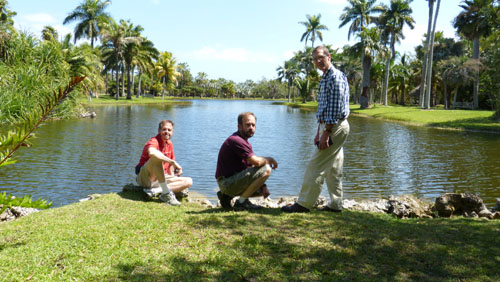 The Three of Us at Clarke Lake |
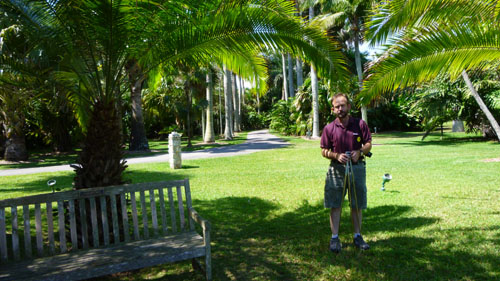 Along the Path at Clarke Lake |
The lake was quite pretty from where we were standing, but we'll get to that in a moment. When we were at the shore, which was constructed of coral rocks, setting up for our group shot, I noticed two huge turtles near the shore, and when we'd taken our picture, I turned to have a look at them. They must have been curious, for they came right up to the shore and almost came out of the water. We all thought they were fascinating, and took a good many pictures of them. You might not want to see them all, but you can click on the thumbnail images below to see as many of them as you wish:
 |
As I said, the view from the shore of Clarke Lake, looking out east across the various natural areas of Fairchild, we really neat, and I decided that this would be a good place to create a panoramic view. I created another of my 360° pictures by stitching together seven different pictures. The result is in the scrollable window below:
We continued walking south until we reached the area where the cafe and some of the greenhouse exhibits were found.
The Greenhouse Area
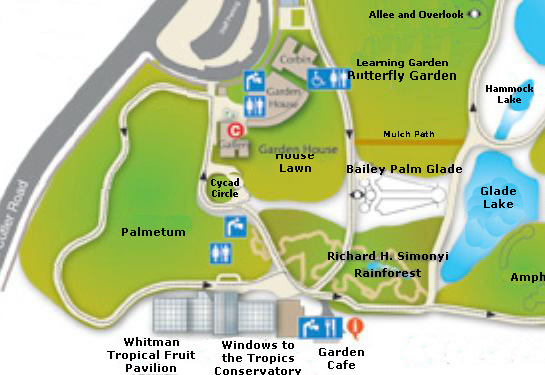 |
The Orchid Garden
|
|
 |
Of course, the main attraction of the Orchid Garden is the orchids, and there was quite a variety of really nice ones, and the three of us spend some time walking around looking at them and, of course, photographing them. You can click on the thumbnail images below to see some of these beautiful, fragile flowers:
 |
Windows to the Tropics Conservatory
|
There is also a horticultural display room, and other greenhouses supply the potted plants that rotate through this display. Here are some of Fairchild's most prized aroids, bromeliads and orchids, along with unusual new species and horticultural selections. Also in this conservatory are flowering trees, palms and cycads, aroids, and ferns representing the plant diversity of the tropical world.
I should also point out that Fairchild Gardens was also hosting an exhibit of blown glass by Chihuly. There were some of his large glass sculptures in the Conservatory and the other greenhouses and in a pond by the educational buildings. There were also some small Chihuly glass pieces sprinkled through some of the greenhouses as well. The exhibit was larger when we were here with Mario and Steve a few years ago, and I can only assume that the Gardens have acquired some of the pieces for permanent display.
There were many interesting and beautiful plants and trees inside the Tropics Conservatory, and we took a wide range of pictures. I have selected the best of these pictures to include here. If you will click on each of the thumbnail images below, you can see the best of the pictures we took:
 |
A Tram Ride Through the Gardens
From the Conservatory, we headed diagonally through the middle of the west side of the gardens towards the tram stop. We crossed the Mulch Path and across the top of an area that is actually an elevated garden section overlooking the main path that we had followed just a bit earlier.
|
 |
We had some time before the next tram departure, so we stopped at the little garden cafe to get a bit of lunch, which we ate on the little patio adjacent to it. Then we walked over to the tram and hopped on, waiting for its departure. That's where Fred got a picture of Guy and I on the tram.
On the garden map at left, I've marked the route the tram took. It went first around the border of the main garden and back around and down by the Conservatory and Cafe where we had just been. We planned to walk through that area of the garden a bit later, and so we did not bother to take a great many pictures as we went along. We did take a few, though, among the most interesting of which was a picture of the largest tree in the gardens. At its base is an interesting bronze sculpture that the tram hostess said was of one of the gardens most important patrons, now deceased. You can see that sculpture here. If you would like to see some of the other pictures Fred took from the tram during this portion of the ride, just click on the thumbnail images below:
 |
Passing the cafe, the tram headed east through these relatively undeveloped areas of the garden. We passed by the Lowlands and then crossed a main park road heading east by Fan Palm Lake. We drove through the Pine Rockland, and we could get a view across Vee Lake towards an area marked as "Africa (future)" on the park brochure map. We continued around the end of Center Lake, and passed through areas of bamboo, palms and coconut palms. The whole area was very restful, and we passed hardly anyone.
Fred took some nice pictures from the tram, and you can click on the thumbnail images below to have a look at them:
 |
The tram made a large circle through the east side of the gardens, returning eventually to our starting point at the tram stop.
Our Walk Through the West Garden
|
The Victoria Amazonica Pool
|
|
Near the pool Fred spotted a lizard (or maybe an iguana) and he snapped a few pictures of it- one quite close up. He also took some nice pictures of the pool itself, and you can click on the thumbnail images below to have a look at them:
 |
The Vine Pergola
|
Walking through the pergola was interesting, and not the least reason for that interest were all the little tags that were hanging on some of the vines. (On the previous picture, they look like water spots all over Fred's camera lens.) I was able to discover their purpose on the Fairchild Gardens website. The tags were part of an interactive exhibit by Yoko Ono called "The Wishing Grove." It allowed guests to write a wish and tie it on one of the vines. The wishes were collected from similar exhibits worldwide and placed in the Image Peace Tower in Iceland. You can see more of them in this picture of Guy walking through the pergola. We walked up and down the shady pergola, finally heading towards the end of the pergola.
|
Just beyond the bougainvillea we found a climbing vine with bright green flowers hanging from it. As it turned out, the plant, which Fred had never seen, was called Jade Vine, and just a little ways away there was an informative sign about it. I have reproduced part of the sign at left so that you can read it.
The Arid Garden
|
Some of the cacti were blooming, and Fred got a really nice closeup of one of those colorful blooms; you can have a look at it here.
|
As we continued down the path towards the Garden House, we passed a huge tree on our right- huge because it had one of the largest trunks I'd ever seen that wasn't a sequoia. It might not look too large in that picture, but Fred took a picture of me standing next to it with my arms spread out for scale; have a look at that picture here.
On our left, there was another interesting tree; this one was interesting because of its flowers, many of which had dropped off and were laying all over the ground. They reminded me of what we used to call a "powderpuff tree" in Charlotte, except that these "puffs" were much, much larger. I picked up one of the recently fallen ones that was still whole, and had Fred take a picture of it. Have a look at this amazing flower here.
The Garden House Lawn Overlook
|

|
We enjoyed walking along the path through this part of the garden. In addition to the stops we made that I showed you already, we passed interesting trees and plants and places to sit down an rest. Click on the thumbnail images below to see some of the other pictures we took as we were walking through this part of the garden:
 |
From the overlook spot, we turned and went back along the path the way we'd come, except that we cut across the lawn to stop by some wood sculptures that were out in the middle of the lawn.
The Hugo Franca Wood Sculptures
|
| "Instead of masking it, he accentuates the natural quality of his materials. The pieces are organic and show a true appreciation and understanding of nature” the Fairchild press release announced. |
 |
The Brazilian artist-sculptor uses all natural materials to create purposeful and sustainable designed pieces like Chaises and Benches. Each piece is made from reclaimed wood from felled, burned or dead trees found exclusively in Brazil. Sixteen pieces of Franca’s unique woodwork sculptures are currently on display in the Gardens.
|
Click on the thumbnail images below to see some more of Franca's sculptures:
 |
| "Mr. Franca’s work is truly unique and I think it will attract much attention here at Fairchild." |
We certainly found it enjoyable and fun.
The Cannonball Tree
|
This was the most unusual tree in the Gardens (and one of the oddest I have ever seen). You can read about it on the sign at left, and you can click on the thumbnail images below to see our pictures of the flowers and fruit.
 |
We left the Gardens about four o'clock to head back to Fort Lauderdale. I know Fred and I enjoyed our second visit to the Gardens, and I think Guy found it immensely interesting as well.
 |
Return to Our Spring Trip to Florida |